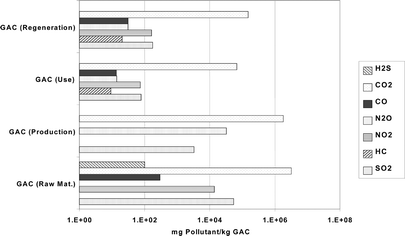A traditional approach used to evaluate clean-up technologies, in which only plant discharges are considered, is contrasted with a sustainability assessment. The sustainability of any technology can be assessed from three complementary points of view: economic, environmental and social. As such, this paper presents a comprehensive scheme that can be applied to any process, product or technology. In addition, the use of chemical engineering tools such as process design, process modelling and simulation represent a baseline for the sustainability assessment of technologies, as presented in a case study. The optimal granular activated carbon adsorption process design is used as a model system to demonstrate the advantages of sustainability approaches over traditional approaches. A mathematical model that describes the performance of the process at various design options was developed. This model includes cost equations that were used to estimate the total cost of each alternative under different plant designs and two waste scenarios (a benzene and a 1,2-dichloroethane discharge). Life Cycle Assessment tools were applied to generate an inventory of emissions and the impact assessment measured as Photochemical Ozone Creation (POC) and Global Warming Potential (GWP). The model examined trade-offs between pollutants discharged into the atmosphere and pollution associated with the adoption and operation of the technology. One of the main results from the technology assessment is that the environmental impact, measured in terms of GWP proved to be higher for the technology operation than for the untreated waste streams themselves, and therefore suggested that the streams should not be treated. However, the social impact evaluation (measured as risk assessment) conducted as part of this work proved that it was morally and legally mandatory to treat them due to the adverse effects on human health that they may represent. As such, a triple bottom line sustainability assessment was demonstrated to be one of the most important frameworks for decision making. The evaluation scheme presented in this work can also be applied to other areas such as the identification of the most sustainable process design and different green chemistry route alternatives.

You have access to this article
 Please wait while we load your content...
Something went wrong. Try again?
Please wait while we load your content...
Something went wrong. Try again?


 Please wait while we load your content...
Please wait while we load your content...